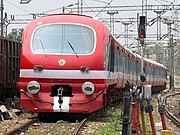Railways


India's rail network is the longest of any country. Trains run at an average of around 50-60 km/h, which means that it can take more than two days to get from one corner of the country to another. Rail operations throughout the country are run by the state-owned company, Indian Railways. The rail network traverses through the length and breadth of the country, covering a total length of around 63,000 km (39,000 miles). Out of this a total 16,693 km of track has been electrified till now and 12,617 km have double tracks.

Indian Railways uses three type of gauges : Broad Gauge, Metre Gauge and Narrow Gauge. Broad gauge at 1.676 m is one of the widest gauge used anywhere in the world. Indian Railways is in the process of converting all the metre gauge (14,406 km) into broad gauge. Narrow gauge (3,106 km of track) with a width of 2 ft (610 mm) to 2 ft 6 in (762 mm) is restricted to very few places.
Buses

Next only to railways, the most preferred long distance transport option for the public are the buses. Most of the state road transport corportations have buses which connect major cities and towns.
There are private bus operators who run regular schedule of buses for connections between major cities and towns. Most long distance buses are scheduled during the night. Long distance travel in buses is quite common for distances up to 500 km. In some cases there are connections for distances like 1000 km (eg. Bangalore to Mumbai), with a travel time of 24 hours. With the advent of better buses (eg. Volvo's popular Volvo B7R) and better highways, road transport has become a fast and comfortable option for travellers.
No comments:
Post a Comment